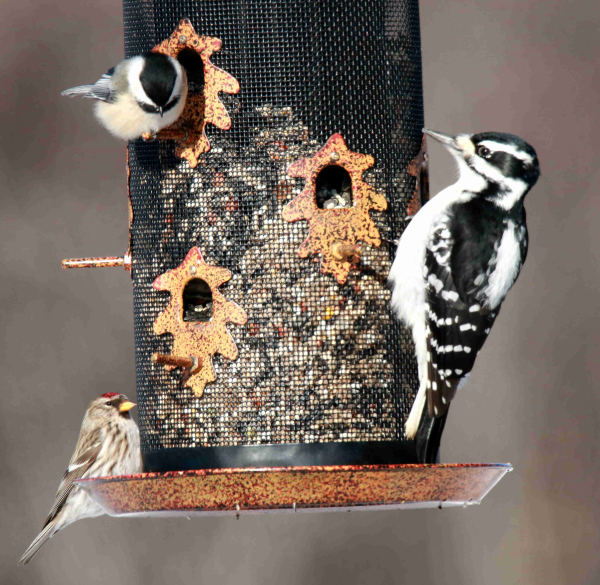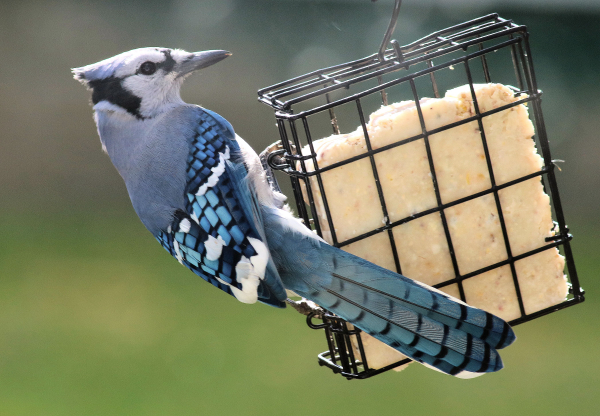
Provide a variety of foods to attract a variety of birds – such as this combination of a Hairy Woodpecker, Common Redpoll, and Black-capped Chickadee (photos by Paul Konrad).

Suet is a staple food offering for a variety of birds at any feeding station.
|
Fall migration can provide some of the most interesting, most exciting, and most surprising birds in our yards. It may be single birds, it may be a flock of birds, or it can be mixed flocks. With the clear change in weather and increasing numbers of songbirds migrating, it’s time to increase and even change the variety of foods we are providing at our feeding stations. There are other regional considerations for areas of the Sunbelt during fall too, and fresh water for drinking and bathing is always an important part of any feeding station.
While goldfinches may already be regular visitors at your thistle seed feeder, they will soon be joined by a greater variety of “winter” finches – Purple Finches, Pine Siskins, Common Redpolls, Pine Grosbeaks, and Evening Grosbeaks could grace your yard this season. Some of the larger finches will prefer larger seeds, along with Northern Cardinals, especially black oil sunflower seeds. If you prefer to avoid the mess of discarded shells, offer shelled sunflower seeds – that’s our personal preference because it keeps our feeding station free of shells, and we aren’t paying for the weight of shells – only seeds. Of course, other popular birds will benefit from high-energy black oil sunflower seeds – chickadees, jays, quail, towhees, native sparrows, nuthatches, woodpeckers, and more.
Woodpeckers and nuthatches often prefer suet to seeds, although that can depend on individual preferences. Regarding suet, we provide no-melt suet; in fact, we offer suet made with hot pepper, that essentially repels squirrels, but not birds. If you’re trying to avoid squirrels, avoid seed mixes with corn and, frankly, we avoid seed mixes. We get the same birds by providing straight sunflower seeds, and we avoid filler types of seeds that dominate many seed mixes and either end up uneaten on the ground or end up attracting blackbirds, House Sparrows, and rodents.
Peanuts are popular with a variety of birds, as long as they don’t attract unwanted birds and rodents, including squirrels. You can address that problem by feeding peanuts in a squirrel-proof feeder, or a feeder hung on a predator-proof/squirrel-proof pole or hanger. If you are a squirrel person, we’d suggest setting up a special squirrel feeding site, well removed from your bird feeding station – leaving the feeding station to the birds without the dominating activities of squirrels.
While you want to keep your feeders clean, it’s equally important to keep the area surrounding your feeding station clean. Any “mess” will mostly include seed shells on the ground – primarily sunflower seed shells and peanut shells – which can be avoided by providing shelled seeds. It beats raking, shoveling, and disposing of seed refuse regularly.
Sunbelt Options
In addition to the above foods and suggestions, birders living in warmer parts of our southern states have a few more options: Sugar-water nectar is the obvious offering northern birders pack away until April, but with hummingbirds a regular part of the avifauna in places like southern California and southern Arizona, along with southern Texas, other Sunbelt areas seem to be attracting more and more winter hummingbirds – Louisiana included. Providing late-fall or even winter sugar-water nectar won’t prevent hummingbirds or any other species from migrating, and some lingering orioles and House Finches will appreciate sugar water too.
Most orioles migrate south of the American border, except some Baltimore Orioles overwinter throughout the Florida peninsula; plus Altamira Orioles are full-time residents of southern Texas. In these areas you will want to provide grape jelly and sliced oranges to attract colorful orioles, and some other birds may feed on the oriole preferences too.
Variety & Fill ‘er Up
Fall migration brings a variety of birds from the north – from Canadian grasslands, northern forests, even the Arctic tundra. They may quickly pass through your area, some may remain some days or weeks, and others will populate your neighborhood for the winter, or some part of it. Certainly, that’s part of the fun each fall as new species or birds we haven’t seen since spring migration arrive. Don’t miss the opportunity to host a new or favorite species this fall – and any season.
Give your feeding station daily attention. It may simply be a matter of checking to see if there is ample food and fresh water, and when appropriate topping them off. We like to suggest not to wait for a feeder to be empty or your water feature dry before taking action: “Fill feeders and bird baths before they are empty,” we always say.
Overall, everyone has a little different situation, with different habitats surrounding their feeding station, including urban and suburban habitats, and others. These variations can create different bird communities at locations just 10 miles apart, much less across a state or the continent. The key is to provide the foods that will attract the birds you most want to share your yard and feeding station with. It’s an exciting time of the year as the potential of new birds appearing on an almost daily basis approaches – or is it already happening in your yard? Enjoy the season!
Share your backyard birding experiences and photos at editorstbw2@gmail.com